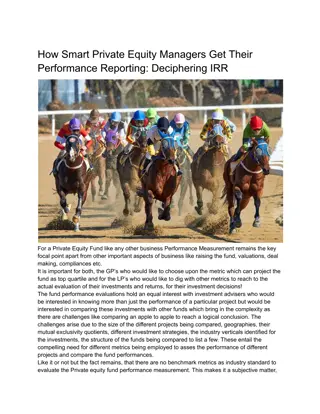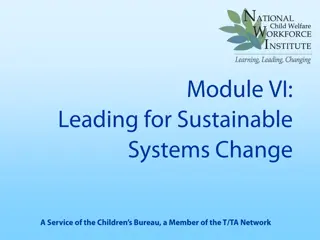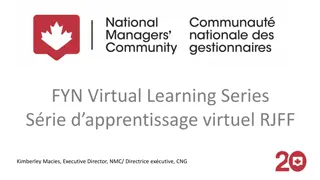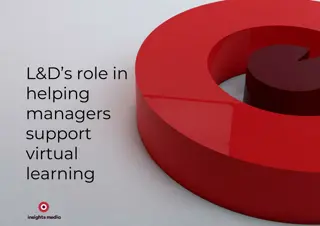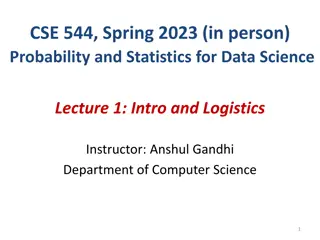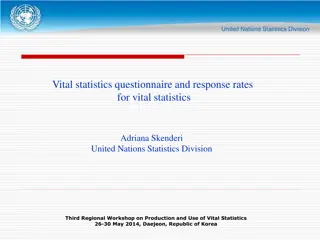Statistics for Managers: A Comprehensive Course Overview
This course aims to equip managers with statistical skills to analyze data effectively and make informed decisions in various management areas. It covers topics such as measures of central tendency, statistical models, and the importance of statistical analysis in improving business decisions. The instructors are experienced professionals in the field, guiding participants through practical applications of statistical techniques.
Download Presentation

Please find below an Image/Link to download the presentation.
The content on the website is provided AS IS for your information and personal use only. It may not be sold, licensed, or shared on other websites without obtaining consent from the author. Download presentation by click this link. If you encounter any issues during the download, it is possible that the publisher has removed the file from their server.
E N D
Presentation Transcript
Date Session Topic Time : 11.01.2021 : 04 : Statistics for Managers (Preface Discussion) : 12.15 PM
Course Instructors Dr. G. NAVEEN KUMAR B.Sc. (C.S.Engg.), MBA, SLET, PhD Head of Department Dr. I. J. RAGHAVENDRA MBA, M.Com, M.Phil, MHRM, PhD Associate Professor Mr. K. SUDHEER Assistant Professor MBA, (PhD)
COURSE AIM/S The course aims to encourage thinking statistically. It will encourage you to develop your abilities to understand and use data. It is designed to equip managers with the skills to make effective use of data in the workplace, to develop expertise in a standard set of statistical and graphical techniques that will be useful in analyzing data, and to learn to apply these techniques in a number of areas of management.
COURSE OUTCOME/S Appreciate that the collection and statistical analysis of data improves business decisions and reduces the risk of implementing solutions that waste resources and effort. Select and deploy the correct statistical method for a given data analysis requirement. Achieve a practical level of competence in building statistical models that suit business applications. Recognize, develop and distinguish between models for cross- sectional analysis at a single point in time and models for time series analysis at multiple points in time.
UNIT-I INTRODUCTION TO STATISTICS Overview: Origin and Development - Managerial Applications of Statistics - Statistics and the Branches of the Study - Statistics & Computers - Limitations of Statistics.
Objective: To know the origin and development of statistics and their linkage to management applications. Outcome: To understand the importance and usage of statistics. Overview: Statistics, quite simply, is about learning from sample data. You face a group of individuals - perhaps people, but maybe cans of tomatoes, or automobiles, or fish in a lake, or even something as nebulous as calendar weeks. Thus statistics is a set of concepts, rules, and procedures that help us to organize numerical information in the form of tables, graphs, and charts, understand statistical techniques underlying decisions that affect our lives and well-being; and make informed decisions.
UNIT-II MEASURES OF CENTRAL TENDENCY Measures of Central Tendency: Mean - Median Mode. Measures of Dispersion: Range - Quartile Deviation - Mean Deviation - Standard Deviation and Co-efficient of Variation. Skewness: Karl Pearson Co-efficient - Bowley s Co-efficient - Kelley's Co-efficient. (Theory and Problems, Discussion on Direct and Indirect Methods of Solving the Problems).
Objective: To know the concepts and their calculation methods. Outcomes: To learn the basic calculations and usage of statistical methods in current scenario.
Overview: One of the important objectives of statistics is to find out various numerical values which explain the inherent characteristics of a frequency distribution. The first of such measures is averages. Averages are the typical values around which other items of the distribution congregate. This value lies between the two extreme observations of the distribution and give us an idea about the concentration of the values in the central part of the distribution are called the measures of central tendency. It is a statistical measure that determines a single value that accurately describes the center of the distribution and represents the entire distribution of scores. The goal of central tendency is to identify the single value that is the best representative for the entire set of data. They are also classed as summary statistics. The mean, median and mode are all valid measures of central tendency, but under different conditions, some measures of central tendency become more appropriate to use than others.
UNIT-III TABULATION Classification and Tabulation: Univariate - Bivariate - Multivariate Data - Data Classification and Tabulation. Graphical Presentation of Data: Diagrammatic and Graphical Representation of Data - One Dimensional - Two Dimensional - Three Dimensional Diagrams and Graphs.
Objective: To know the tabulation methods for representing data in precise manner. Outcome: To be able to frame the representation of data in tabular and graphical methods. Overview: Data can be collected from a source by using different methods. Usually the collected data will be in questionnaires, schedules or response sheets. It is the duty of a statistician to consolidate the data. We can include a huge volume of data in a simple statistical table and one can easily get an overview about the sample by observing the statistical table rather than the raw data. Tables are highly useful for further statistical analysis and interpretation. The tabulation of data in a meaningful way and various types of graphical representation to make the data easily comprehendible.
UNIT-IV SMALL SAMPLE TESTS Sample Test: t-Distribution - Properties and Applications - Testing for One and Two Means - Paired t-test. Analysis of Variance: One Way and Two Way ANOVA (with and without Interaction). Chi-Square distribution: Test for a specified Population variance - Test for Independence of Attributes.
Objective: To know various sample tests. Outcome: Students are able to test the data by using various techniques this can represent data in useful manner. Overview: Sampling problems dealt with means and proportions. Evaluation of the sampling errors was based on the normal distribution. A small sample distribution, known as the t-distribution, has to be used in this case. When samples are small and the distribution of the variable in the population is not normal, there is no readily available sampling distribution. In the case of the mean, the sampling distribution was normal because the variable was distributed normally in the population or because the Central Limit Theorem ensured normality for large samples. In the case of proportions, the normal distribution was used as an approximation for the underlying binomial distribution. When dealing with proportions coming from small samples, it is necessary to use the exact binomial distribution.
UNIT-V CORRELATION AND REGRESSION ANALYSIS Correlation Analysis: Scatter Diagram - Positive and Negative Correlation - Limits for Coefficient of Correlation - Karl Pearson s Coefficient of Correlation - Spearman s Rank Correlation - Concept of Multiple and Partial Correlation. Regression Analysis: Concept - Least Square Method - Two Lines of Regression - Properties of Regression Coefficients. Time Series Analysis: Trend analysis - Free Hand Curve - Moving Averages.
Objective: To know the correlation and regression analysis of data. Outcome: To be able to analyze the data by using time series, correlation, regression, etc. and their usage importance for taking decisions. Overview : Correlation is statistical Analysis which measures and analyses the degree or extent to which the two variables fluctuate with reference to each other. It indicates that there is some connection between the variables. It does not indicate cause and effect relationship. Price and supply, income and expenditure are correlated. Regression analysis reveals average relationship between two variables and this makes possible estimation or prediction. The relationship between two variables can be considered between, say, rainfall and agricultural production, price of an input and the overall cost of product consumer expenditure and disposable income. Time series Analysis helps us understand what are the underlying forces leading to a particular trend in the time series data points and helps us in forecasting and monitoring the data points by fitting appropriate models to it.






